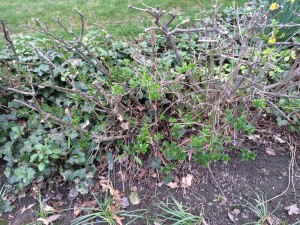My husband and I try to walk at least three evenings a week for an hour. Lately, I can’t help but notice what a toll the past two winters have taken on privet hedges. They look absolutely terrible, mostly bare except at the base. With a few exceptions, there is little growth in the middle or near the top.
This is a golden opportunity for homeowners to take out their angers and aggressions. Whip out those pruning shears and loppers and start chopping! Prune down as far as the new bottom growth and then cut just above a new leaf. This is called rejuvenation pruning. The hedge won’t look good again for at least a year but privet is extremely hardy and very difficut to kill.
Hedges don’t need to be seven feet tall. Their purpose is usually definition of space rather than privacy. Even a two foot hedge will suffice.

Privet hedge that has been pruned for rejuvenation still has stubs. If you look closely, you see mostly ivy and stubs. Those stubs should all be pruned back. Cutting this far back allows an excellent view of volunteer plants.
Winterkill has been the main concern for the past few years but there is another maintenance issue that is mostly neglected. This is the appearance of volunteer trees in the hedge as a result of bird droppings. If you are pruning back your damaged hedge, this is a great time to identify and dispose of the volunteers because the leaves are usually much larger and different in form.
If you find the tree seedlings when they are very young, they can be pulled. A few years later, they need to be dug. Several years later, they have usually been cut many times to keep them at the same height as the hedge and the roots are, by then, intertwined with those of the hedge. The only way to kill them is by repeated applications of Roundup. The Roundup has to be painted on with a brush, not sprayed, because Roundup kills whatever it touches. The repeated applications are necessary because the roots are so strong.
Use the difficulties of the past two winters to revive and beautify your privet hedge.
P.S. If you are not familiar with rejuvenation pruning, watch these two YouTube videos that might help. The links are:




3 Comments